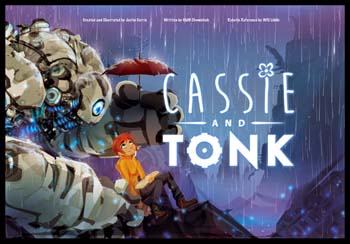| ________________
CM . . .
. Volume XXII Number 25. . . .March 4, 2016
Upon first glance at the cover illustration, one could easily assume that Cassie and Tonk is a complementary follow-up to an already existing children’s animated film. Surprisingly, Cassie and Tonk is an example of an independent, book-before-film project which has acquired a growing fan base since its initial publication in 2014. The story’s mastermind, Justin Currie, sought the assistance of writer GMB Chomichuk and 3D artist Will Liddle, and together, they assembled their unique artistic talents to create a technologically modern, yet traditionally charming, tale that ignites the senses while also capturing the heart and nourishing the spirit. The book is narrated by Cassie, the young protagonist of the story, who finds herself alone and afraid in an unfamiliar, post-apocalyptic world where she is the sole human existing amongst a bizarre array of monstrous robotic creatures. For quite some time, Cassie hides in fear of the creatures she observes, including the Rends whose ferocious mannerisms resemble both dinosaur and dragon as they aggressively search out their prey within the dark, desolate, and barren landscape whose only other occupants are other forms of mechanical creatures, most of whom seem to lack any sign of human emotion. One day, in an attempt to flee from a predatorial Rend, Cassie unexpectedly crashes through a hole in the ground and descends into a small area where she discovers some refreshingly earthly features, including aromatic moss and flowers, which have somehow managed to flourish even amongst a primarily dismal and metallic wasteland. It is in this space that Cassie finds safety, not only in the arms of nature, but also in the company of a newfound friend named Tonk. In direct contrast to the other robotic inhabitants, Tonk is extraordinarily kind, and his friendship with Cassie quickly blossoms into an inseparable bond that carries them on united journeys of adventure and peril. It is through time spent with one another that Cassie and Tonk gradually discover the true meaning of love and the shared commonalities of the heart that exist despite their differences in size and appearance. Sadly, the concluding pages of the book depict Tonk’s unexpected demise at the hands of a Rend. Cassie, although initially heartbroken and filled with sorrow over the loss of her best friend, finds comfort in the memories of the moments they shared together. In the end, Cassie comes to the realization that love never truly dies as it lives on in the hearts and minds of those who loved in return. With newfound strength in her heart, Cassie finds the will to go on, knowing that the love of her best friend Tonk will always be walking beside her, providing her with the courage needed to face all of life’s challenges.
Cassie and Tonk is presented in the style of a graphic novel, with small boxed inserts of text integrated throughout the story which resemble a comic format. The illustrations are digitally produced via 3D art and the use of sculpting software that enabled the book’s creative team to present facial expressions and action sequences in a manner which mirrors the techniques applied in the production of animated motion pictures. The high quality, movie-like appearance of the illustrations will undoubtedly appeal to a wide range of readers, particularly those who are aficionados of creative graphic art. The book will also capture the attention of those seeking a motivationally and emotionally powerful read. For educators, the plot would serve as an ideal introduction to classroom discussions on the topic of friendship and finding courage amidst difficult times. Unlike most children’s picturebooks which rarely depict experiences associated with death, the story’s creative team boldly, yet eloquently, places the passing of Tonk at a key moment in the storyline and uses it as an honest reminder to readers that the loss of loved ones is never easy, regardless of whether they are human or robot. Subsequently, Cassie and Tonk offers new meaning to Alfred Lord Tennyson’s popular adage of “Tis better to have loved and lost than never to have loved at all”. Though minimal in words, the poignant message of Cassie and Tonk clearly shines through, reminding its readers of the hope and new beginnings that are often born out of even the most unlikely of friendships. Highly Recommended. Christina Quintiliani is an Ontario Certified Teacher and Ph.D. Candidate researching children’s literature at the Faculty of Education, Brock University, St. Catharines, ON.
To comment on this title or this review, send mail to cm@umanitoba.ca.
Copyright © the Manitoba Library Association. Reproduction for personal use is permitted only if this copyright notice is maintained. Any
other reproduction is prohibited without permission.
CM Home |
Next Review |
Table of Contents for This Issue - March 4, 2016
| Back Issues | Search | CM Archive
| Profiles Archive |
